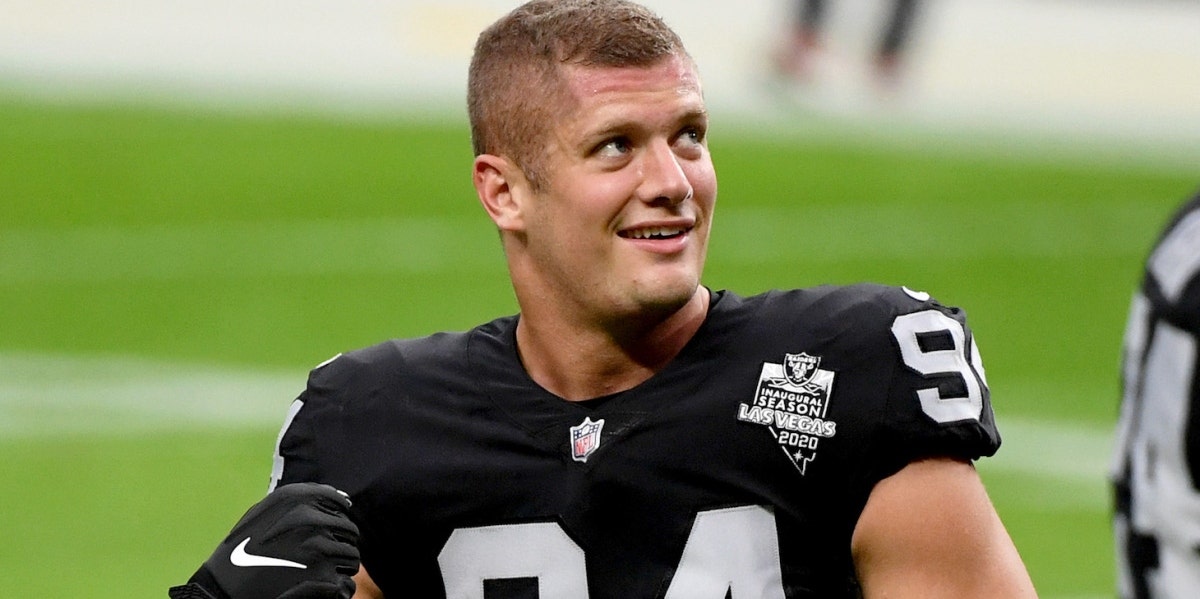Gay NFL Players Always Existed — Why Carl Nassib Coming Out Renews Hope Of Changing League's Culture
It's a win for LGBTQ acceptance.
 Getty Images
Getty Images Raiders defensive lineman Carl Nassib has become the first openly gay active NFL player after coming out publicly on June 21.
“I just want to take a quick moment to say that I’m gay,” Nassib said in a video posted to his Instagram account. “I just think that representation and visibility are so important.”
He added that he “agonized” over the decision to come out for 15 years, five of which have been spent in the NFL.
Nassib’s coming out offers a glimmer of hope for improved LGBTQ representation in one of the world’s most hyper-masculine sports.
LGBTQ NFL players have criticized the league's "don't ask, don't tell" culture. Will it change now?
The NFL has not always been the most accommodating place for LGBTQ players who have kept their sexualities hidden throughout their football careers.
In 1975, former NFL player David Kopay became one of the first professional athletes to ever come out. He had ended his football career three years earlier but his coming out still was not well received in the sporting community.
“I couldn’t get a job, couldn’t get a coaching position, no one wanted to hire me. It was like I committed murder,” he said last year, criticizing the continued lack of acceptance in US sports.
“I could never have imagined that nearly 50 years later we would still have no openly gay athletes in America’s Big 4 sports.”
At least two NFL players came out before Nassib, but neither played professionally after doing so.
In 2014, Michael Sam came out as gay just before the NFL draft.
If anyone had hope Sam would become an agent of change, their hopes were quickly dashed as Sam, who had been drafted by the St. Louis Rams in the 7th round was cut from the sport before playing even one actual season.
Then in 2019, NFL free agent Ryan Russell came out as bisexual in an essay written for ESPN.
"Today, I have two goals: returning to the NFL, and living my life openly," Russell wrote. "I want to live my dream of playing the game I've worked my whole life to play, and being open about the person I've always been."
He has not played professionally since.
NFL prospects report being asked if they "like men."
The league has consistently avoided any interrogation surrounding their treatment of LGBTQ players, mainly because they’ve avoided welcoming them.
It is absurd to suggest that the entirety of the NFL, with at least 50 men per squad, is composed of heterosexuals, but that’s what the culture of the sport would have us believe.
Reports of NFL prospects being asked bizarre questions about their drug habits or whether or not their mothers are sex workers are may be anecdotal, but such practices are believed to serve to cover the league’s invasion player’s personal lives and discriminate based on their findings.
Players like Eli Apple and Derrius Guice claim to have been asked about their sexuality and probed about whether or not they “like men.”
It’s clear from the NFL’s lack of LGBTQ representation what the desired response to that question is.
The league may not have full control over whether or not there are gay players in the sport, but they have certainly put in the work to ensure these players don’t feel comfortable coming out.
Homophobia thrives in the NFL.
Locker rooms and playing fields can be breeding grounds for homophobia and machoism.
Esera Tualo, a former Packers player who came out after leaving NFL, said in his autobiography that homophobic slurs were a staple in locker room chats.
He also recounted a story of fellow player Sterling Sharpe’s reaction to the possibility of their being non-straight players on his team.
“He said if the guys found out another player was gay on a Monday, he wouldn’t be able to play on Sunday.”
These kinds of comments reinforce the culture of silence that oppressed LGBTQ players and allowed homophobia to fester.
Nassib’s coming out shines a light on an identity that the NFL historically believed did not exist in their ranks.
Giving young fans an opportunity to cheer on an openly gay player who defies outdated notions of what a macho NFL player should act like paves the way for a wider acceptance of the LGBTQ community.
The NFL’s new generation of socially active players are now part of a league that welcomes LGBTQ fans clubs, walks in Pride parades, and sells non-gendered apparel.
The culture is shifting somewhat, as Nassib’s announcement has been generally well-received.
Yet, what the league really needs to take stock of is what has made coming out so “agonizing” for players like Nassib.
Using the momentum of Nassib’s coming out to breed a new culture of acceptance may be the only way to undo the century of LGBTQ discrimination within the sport.
Alice Kelly is a writer living in Brooklyn, New York. Catch her covering all things social justice, news, and entertainment. Keep up with her on Twitter for more.
